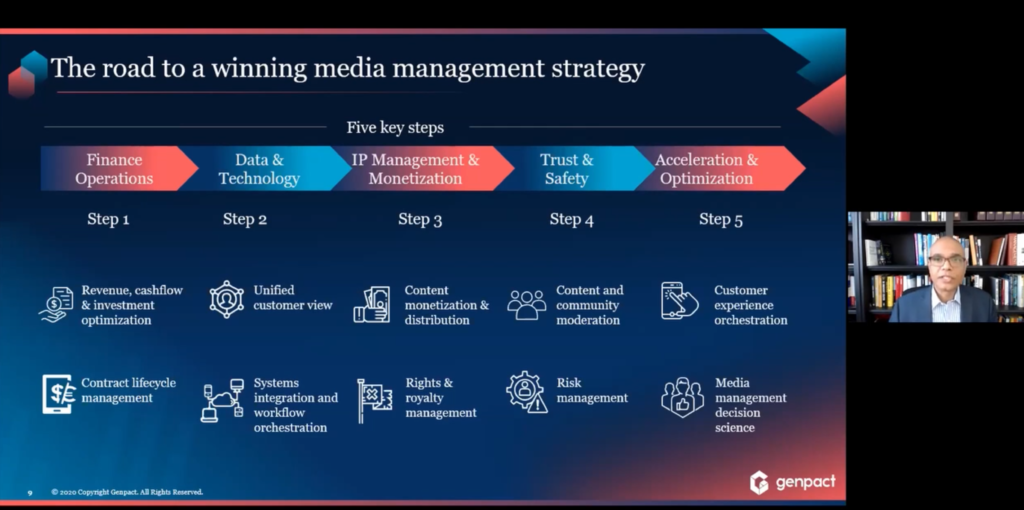Connections

Genpact Highlights Road to Winning Media Management Strategy
Story Highlights
As media businesses pivot to drive revenue from digital channels, it’s essential that they fully understand and be prepared for the complex nature of content streaming and how to rethink distribution, monetization and rights compliance, according to Genpact.
“What a year it’s been – filled with transformation – and what a journey it’s been for us,” Mitesh Motwani, associate partner, Analytics Advisory at Genpact, said during the Dec. 8 virtual Content Protection Summit.
Thinking about the “momentum” achieved in this space, “I get pretty nostalgic” for the days when we all used to have disc libraries, he pointed out during the Scale & Remote Access breakout session “Media Management in a Streaming World.”
During the presentation, he and Brajesh Jha, global head of media and entertainment at Genpact, provided their take on what it will take for media companies to achieve a winning media management strategy.
Jha pointed to one positive of the pandemic: “At least I get to spend more time with my kids.”
 The current media management situation brings to mind a story from several years ago, he said, recalling he “had this massive collection of my favorite CDs and audio cassettes in my personal library.” During a Thanksgiving/Black Friday deal special, he got a 2-TB external drive and converted all his audio into MP3 files and set up a local storage service that was running all the time, he said, noting: “I was so proud of myself.”
The current media management situation brings to mind a story from several years ago, he said, recalling he “had this massive collection of my favorite CDs and audio cassettes in my personal library.” During a Thanksgiving/Black Friday deal special, he got a 2-TB external drive and converted all his audio into MP3 files and set up a local storage service that was running all the time, he said, noting: “I was so proud of myself.”
He decided, at the time, to then try and take “the next step” by taking all his DVDs and video cassettes and see if he could create a video streaming service. His wife and kids were ready to watch the first streamed video but he immediately ran out of memory and the stream just kept buffering, he recalled.
Now, however, “is the golden time for streaming” with an enormous amount of content available to viewers, he said, noting: “We have come a long way from those early days of home-grown streaming solutions.”
And that brought him to the presentation’s topic: Media management in a streaming world.
“We consume all kinds of music and video via streaming” and there are a “plethora of options” available to consumers today, he said, pointing as examples to the new Discovery Plus and HBO Max, which recently announced it will stream all new theatrical releases day-and-date with their theatrical releases in 2021.
Disney Plus has been a “stupendous success,” he also said, pointing to the fact that it achieved 50 million subscribers in just five months and has gone on to attract several million more subscribers since then.
Key streaming trends
This “war of streaming has just begun” but “there are important trends that are emerging out of it” already, according to Jha.
“What we have seen is that trends that were already in place have been accelerated faster than anybody could have ever imagined,” Motwani told viewers.
About 1.4 billion over-the-top (OTT) viewing hours per month are now being racked up, with many people now home most of the time amid the pandemic, Motwani said. He called that a “staggering” number, adding they are doing it across many devices and platforms.
Last year, we were at about 1.2 billion OTT hours viewed per month, so there has been an additional “200 million incremental viewing hours per month on OTT alone,” he said, adding: “We have pulled the demand up front by almost three years” because what was on track to happen in 2023 or 2024 has now been achieved in 2020.
In streaming revenue, last year we were at about $83 billion globally and that has grown to a projected $100 billion in 2020, including ad-based and subscription business models, he noted.
For 2020, the industry in February 2020 was only expecting 192.7 million OTT video subscribers in the U.S., but the forecast changed to an estimated 207.5 million in August 2020, he said, pointing to eMarketer data. What’s been achieved this year in the U.S. has, therefore, even surpassed the 207.1 million projection for 2023, he noted.
As a result, the U.S. OTT subscription market is “getting pretty mature,” he pointed out, predicting it “will become a winner takes all space where maybe three or four players dominate — and we are already seeing some of those beginning to dominate.”
The other players “will need to either get consolidated or partner with the bigger players to reach that sort of mass scale” in the U.S., he said.
 A lot of the growth we see for OTT in the coming years will come from emerging markets, he predicted.
A lot of the growth we see for OTT in the coming years will come from emerging markets, he predicted.
He also predicted we will see incremental growth of 14.5 million OTT subscribers by 2024. Meanwhile, revenue that was expected to be $100 billion by 2025 is now expected to increase to $167 billion by that year, representing growth of 67% by 2025, he said.
Delivering best-in-class experiences will be more important for these services than ever before as a result, he pointed out.
And the customers entering the streaming sector now are a “very different breed” from prior customers, he said, identifying them not as early adopters and predicting they will likely “stick around if they feel that they’re getting their money’s worth” and “drive long-term growth” for streaming service providers in the future, with a 92 percent long-term retention rate.
Opportunities for those who manage media wisely
“These are very important trends” and “represent significant opportunities” for media companies, Jha said.
The shift caught most traditional media players off-guard, according to Genpact, which he said works closely with M&E clients.
“They have to look at the overall picture holistically” when it comes to media management, he said, adding data is the foundation of all of this and companies must figure out whether “they have the right ecosystem with respect to data in place or not.”
Other important questions for media companies to ask when it comes to their media management strategies, he said, include: “Do they have IP management and monetization solutions that can be deployed easily within the existing tech landscape? Do they have years of technology debt accumulated which will get in the way and create massive bottlenecks? And have they finally become aware of the issues around trust and safety, or are they keeping that on the side, thinking ‘oh, it will just take care of itself?’”
Other issues that need to be taken into account – and are by Genpact and its clients – are user-generated content and geographies across the globe, he noted.
There are three basic types of streaming business models: Ad-supported; premium subscription-based; and transactional, one-off payment-based, he pointed out.
 An advantage of the ad-based model is it’s easy to get new subscribers with it and “you could open the path to premium if you have a decent amount of content,” he said. However, the “downside” is that initial customers may get turned off by the ads, he noted.
An advantage of the ad-based model is it’s easy to get new subscribers with it and “you could open the path to premium if you have a decent amount of content,” he said. However, the “downside” is that initial customers may get turned off by the ads, he noted.
The premium, sub-based model, meanwhile, is “gaining a lot of popularity” but it “take time to build a loyal set of subscribers” and disputes can mean you may lose audience, he pointed out.
And the transaction-based model is very simple but one negative of it is there is no consistency in revenue and consumers do not like to pay every time they want to watch something, he noted.
A “holistic” approach to media management includes the content strategy, IP management and finance operations, Motwani said.
What Genpact is hearing from its customers is that linear ad revenues have dropped as much as 60%, he told viewers.
Those streaming players who were not ready for this major shift to OTT have been hit “really hard,” he said, noting they tended to not have a unified view of their customers.
Five key steps to a winning strategy
The road to a winning media management strategy includes five key steps, according to Jha:
1. Finance operations including revenue, cashflow and investment optimization, as well as contract lifecycle management
2. Data and technology including a unified customer view and requiring a modernization of all workflows
3. IP management and monetization including content monetization and distribution, as well as rights and royalty management
4. Trust and safety including risk management: Content and community moderation are required. “If you have a platform that has user-generated content, your entire trust and safety strategy has to incorporate both machine learning and human intelligence-based content moderation. It needs to achieve extremely high accuracy. One failure is too many and there are sometimes lives at stake.”
5. Acceleration and optimization: “It is all about customer experience,” so personalization is needed as part of “customer experience orchestration.”
To access video of the presentation, click here.
Presented by Microsoft Azure, the Content Protection Summit was sponsored by SHIFT, Genpact, Akamai, Convergent Risks, Friend MTS, GeoGuard, PacketFabric, Palo Alto Networks, Richey May Technology Solutions, Splunk, Zixi, EIDR, Cyberhaven and Xcapism Learning.
The event was produced by MESA, CDSA, the Hollywood IT Society (HITS) and Women in Technology Hollywood (WiTH), under the direction of the CDSA Board of Directors and content advisors representing Amazon Studios, Adobe, Paramount, BBC Studios, NBCUniversal, Lionsgate, WarnerMedia, Amblin Entertainment, Legendary Pictures, and Lego Group.









